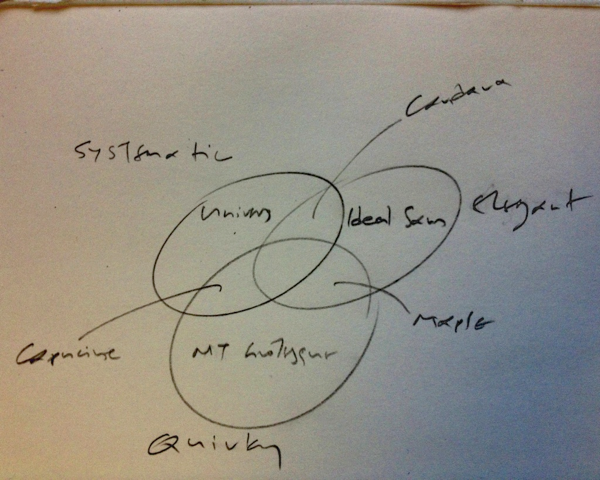[I got asked yesterday by a student in another university “what Information Design (and especially Typography) means to you”, and dumped this out over breakfast; I post it “as is” to avoid going into the black hole of perpetual editing.]
Firstly, typography: this depends on the institutional viewpoint, and the language*. In the English-speaknig world it is a continuum. At one end it refers to the the design of texts at the paragraph level, covering type choice, line measurements, and similar micro-typographic choices. At the other end typography encompasses all choices relating to the construction of a document as a carrier of information that readers engage with because they want or need this information. The critical distinction lies in the engagement with the text: typography, in its wider definition, covers a range of macro choices at the level of the spread, the document as a sequential experience, and the production of a physical or on-screen object.
Information Design covers typographic design where the engagement of the readers with the text is critical and has specific objectives. Navigation (wayfinding, way-showing, route-mapping, and any of a number of similar terms), safety, instruction, and training are the most common applications. At the heart of Information Design is a user-based perspective, and the imperative to test design solutions. As design scenarios migrate to screen-based environments, especially mobile devices, the potential for customisation of information design to each user is increasingly important in its methodology.
My view is that “static” Information Design on fixed substrates (paper, vinyl sheets, plexiglass signs, and so on) is fundamentally different from Information Design on digital environments. In the first case, it strives to maximise the efficiency of the message and eliminate ambiguity for the largest section of the intended audience. In the second, it has the additional function of maximising the value of the information to the specific demands of the user. This is an additional motivation for the reader to engage with the document, and a much more interesting challenge for the designer. Customised paper documents (e.g. utility bills) have tried to bridge the gap between these two poles, with some success, although clearly they will rapidly give way to screen-based versions.
Of course, in all cases Information Design has to carry the identity of the publisher. This is in itself a separate design challenge, usually addressed by aggregating the effect of the designed objects rather than an individual document. For example, a sign system brands a building through the consistency of its appearance, just as much as by the range of the scenarios it enables.
- In Spanish-speaking countries “tipografia” means “type design”. This, as you can imagine, leads to no end of confusions and clarifications.


